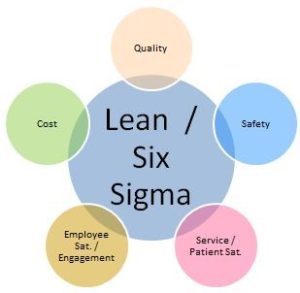- “This program is not just one project/certification, it is a lifetime perspective or awakening when looking at organizational areas of improvement and approaches to take.”
- “This class was very beneficial to both myself and for our organization. I would recommend it to anyone wanting to obtain their green belt. It was flexible enough to fit with a full-time work schedule.”
- “The Green Belt certification has helped me solve problems in health care with data analysis. I learned to use data to tell a story and send a more meaningful message to front-line staff. By applying the lean methodology, it was easier for staff to do the right thing, and by removing barriers, we gained staff buy-in with the project.”
- “This is a great program with an exorbitant amount of knowledge provided. This will definitely help any organization become leaner and improve their processes. I believe this would be a great class for bedside health care workers.”

Lean Six Sigma
Lean Six Sigma is a performance improvement methodology that relies on collaborative team effort to improve performance by removing waste and reducing variation.
It combines Lean and Six Sigma methodologies to eliminate nonvalue-added processes (waste), and at the same time, reduce variation.

Lean Six Sigma provides an operational framework for an organization to improve on its key processes, which may result in operational efficiency and quality of care.
Although Lean and Six Sigma are different processes, they are complementary and share many similarities that allow them to flow together seamlessly. Both processes stress the fact that the customer defines the opportunity/value of the product or service; both rely on data to determine what needs improvement, as well as what impact the new/redesigned process made. Implementation of both processes often result in efficiency and reduction in variation.
These methodologies are designed to work well in the health care setting. The reduction of defects can have a positive impact on medical errors, and using Lean Six Sigma can shorten wait times in hospitals and physician practices, prevent falls and injuries in hospitals and nursing homes, reduce medication errors, and decrease turnaround time of key lab results.
Tools and Resources
Lean Six Sigma Green Belt Project Summaries
MHA sponsored a selected group of hospital care providers on their journey to earn Green Belts through A3 Healthcare’s Lean Six Sigma Green Belt Certification Program. The cohort team projects, including brief recordings, are available to learn more from your colleagues across the state.
LSS Evaluations
- 96% were likely to recommend this certification program to a friend or colleague.
- 100% believe the program will positively impact their organization.
- 100% believe the program will benefit them personally/professionally.
- The average satisfaction score, on a scale from 1-5 where 5 is extremely satisfied, was 4.86.
Contact An Expert

2025 Cohorts
Lean Six Sigma green belt and black belt certification programs are offered at a reduced cost through A3 Solutions Group to employees of Missouri hospitals. LEAN Six Sigma certification combines live, real-time (virtual) training courses and individualized coaching sessions as participants move through the phases of DMAIC: Define, Measure, Analyze, Improve, and Control. Throughout the course, students will apply the knowledge and skills learned in trainings as they work on a required hospital-based improvement project. We are accepting all applications, but additional weight will be given to the applications with a project focus on improvements in the medication administration or reconciliation process. Applications are due Friday, Jan. 3.
MHA Staff
A number of MHA staff have been awarded green and black belt designations in Lean & Six Sigma, and are well qualified to lead and facilitate Lean & Six Sigma process initiatives. Please contact MHA to learn more.











